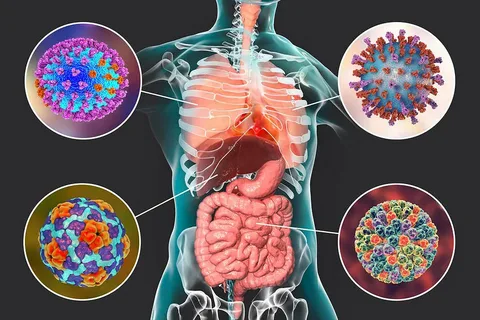Respiratory Syncytial Virus (RSV) has emerged as a significant public health concern, particularly affecting infants, young children, and the elderly. As one of the leading causes of respiratory infections worldwide, timely and accurate diagnosis is crucial for effective management and treatment. The Respiratory Syncytial Virus (RSV) diagnostics market has witnessed substantial growth, driven by innovations that enhance detection methods and improve patient outcomes. This article explores the key growth factors in the RSV diagnostics market, highlighting the innovations fueling industry advancement.
The Burden of RSV Infections
RSV is highly contagious and spreads through respiratory droplets, making it a major threat in crowded environments such as daycare centers and hospitals. Symptoms can range from mild cold-like signs to severe respiratory distress, leading to hospitalizations and, in some cases, fatalities. According to the World Health Organization, RSV contributes to millions of hospitalizations and deaths each year. The increasing incidence of RSV infections has intensified the need for effective diagnostic solutions, presenting a significant opportunity for growth in the diagnostics market.
Traditional Diagnostic Approaches
Historically, RSV diagnosis relied on methods such as viral culture and serological tests. While these techniques provided valuable insights, they often fell short in terms of speed and sensitivity. For example, viral culture can take several days to yield results, delaying treatment and potentially worsening patient outcomes. The demand for quicker and more reliable diagnostic solutions has prompted a shift toward innovative methods that can provide timely and accurate results.
Innovations Driving Market Growth
-
Molecular Diagnostics: The rise of molecular diagnostics has revolutionized the RSV diagnostics landscape. Reverse transcription polymerase chain reaction (RT-PCR) has become the gold standard for RSV detection, offering high sensitivity and specificity. RT-PCR can detect viral RNA in respiratory samples within hours, allowing for rapid diagnosis and timely clinical decision-making. Furthermore, advancements in multiplex PCR assays enable the simultaneous detection of RSV and other respiratory pathogens, providing a comprehensive diagnostic approach that is especially useful during peak respiratory infection seasons.
-
Point-of-Care Testing (POCT): Point-of-care testing has emerged as a game-changer in the RSV diagnostics market. POCT offers rapid results—often in less than an hour—allowing healthcare providers to make immediate treatment decisions. These tests can be performed in various settings, including emergency departments, outpatient clinics, and even at home. The convenience of POCT is particularly advantageous in pediatric care, where quick diagnosis can lead to timely interventions and improved patient outcomes. Companies focusing on developing user-friendly, accurate POC testing solutions are well-positioned to capture a growing share of the market.
-
Next-Generation Sequencing (NGS): Next-generation sequencing technology is gaining traction in the RSV diagnostics landscape. NGS allows for comprehensive genomic analysis, providing detailed information about the virus’s genetic makeup. This capability is invaluable for tracking viral strains, understanding transmission dynamics, and supporting vaccine development efforts. As public health authorities increasingly rely on precise viral characterization, NGS is expected to play a critical role in shaping the future of RSV diagnostics.
-
Artificial Intelligence (AI) and Data Analytics: The integration of artificial intelligence and data analytics into RSV diagnostics is an exciting frontier. AI algorithms can analyze vast datasets from diagnostic tests, electronic health records, and patient outcomes to improve diagnostic accuracy and predictive capabilities. For instance, machine learning models can help identify patterns in RSV infections, enabling healthcare providers to anticipate outbreaks and allocate resources more effectively. Companies that leverage AI in their diagnostic solutions will likely gain a competitive edge in the market.
-
Telemedicine and Remote Diagnostics: The COVID-19 pandemic has accelerated the adoption of telemedicine, paving the way for remote diagnostics in RSV. Patients are increasingly seeking convenient testing options, and at-home rapid tests can facilitate immediate diagnosis while minimizing the need for in-person visits. Telehealth platforms enable healthcare providers to monitor RSV cases effectively, allowing for timely interventions and follow-ups. This shift toward remote diagnostics is likely to shape the future of RSV testing, making it more accessible for patients and families.
-
Regulatory Support and Funding: Government initiatives and funding aimed at combating respiratory infections are also fueling growth in the RSV diagnostics market. Increased investments in research and development, along with supportive regulatory frameworks, are facilitating the introduction of innovative diagnostic solutions. Public health agencies are prioritizing RSV surveillance and diagnostics as part of their overall strategy to improve respiratory health, creating opportunities for diagnostic companies to develop and market new products.
Challenges in the Market
Despite the promising growth prospects, several challenges remain in the RSV diagnostics market. Regulatory hurdles can slow the approval process for new diagnostic tests, requiring companies to navigate complex compliance landscapes. Additionally, there is a need for widespread education and training for healthcare providers to effectively utilize new diagnostic technologies. Ensuring that all stakeholders are equipped to implement these innovations is crucial for maximizing their impact on patient care.
Future Outlook
The future of the RSV diagnostics market looks promising, with ongoing innovations poised to enhance diagnostic capabilities and improve patient outcomes. As technology continues to evolve, the emphasis will be on developing solutions that are not only accurate and reliable but also accessible and cost-effective. Investment in research and development will be essential for advancing diagnostic technologies and meeting the growing demands of healthcare providers and patients.
Conclusion
The Respiratory Syncytial Virus (RSV) diagnostics market is experiencing significant growth, driven by innovations that enhance detection methods and improve patient management. Advances in molecular diagnostics, point-of-care testing, next-generation sequencing, and AI integration are reshaping the landscape and addressing the urgent need for rapid and accurate RSV diagnosis. As these technologies continue to develop, they will play a critical role in enhancing public health responses to RSV infections, ultimately leading to better outcomes for vulnerable populations. The market is poised for continued advancement, unlocking new opportunities for innovation and growth in the fight against respiratory infections.



